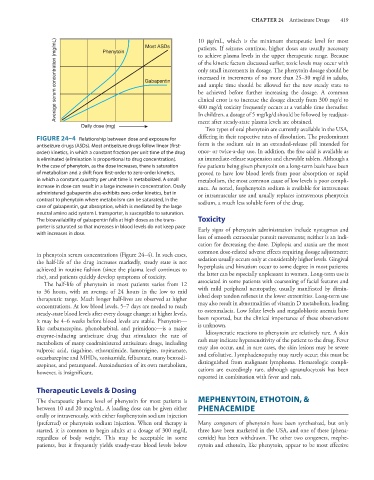Page 433 - Basic _ Clinical Pharmacology ( PDFDrive )
P. 433
CHAPTER 24 Antiseizure Drugs 419
10 μg/mL, which is the minimum therapeutic level for most
Average serum concentration (mg/mL) Phenytoin Gabapentin to achieve plasma levels in the upper therapeutic range. Because
Most ASDs
patients. If seizures continue, higher doses are usually necessary
of the kinetic factors discussed earlier, toxic levels may occur with
only small increments in dosage. The phenytoin dosage should be
increased in increments of no more than 25–30 mg/d in adults,
and ample time should be allowed for the new steady state to
be achieved before further increasing the dosage. A common
clinical error is to increase the dosage directly from 300 mg/d to
In children, a dosage of 5 mg/kg/d should be followed by readjust-
ment after steady-state plasma levels are obtained.
Daily dose (mg) 400 mg/d; toxicity frequently occurs at a variable time thereafter.
Two types of oral phenytoin are currently available in the USA,
FIGURE 24–4 Relationship between dose and exposure for differing in their respective rates of dissolution. The predominant
antiseizure drugs (ASDs). Most antiseizure drugs follow linear (first- form is the sodium salt in an extended-release pill intended for
order) kinetics, in which a constant fraction per unit time of the drug once- or twice-a-day use. In addition, the free acid is available as
is eliminated (elimination is proportional to drug concentration). an immediate-release suspension and chewable tablets. Although a
In the case of phenytoin, as the dose increases, there is saturation few patients being given phenytoin on a long-term basis have been
of metabolism and a shift from first-order to zero-order kinetics, proved to have low blood levels from poor absorption or rapid
in which a constant quantity per unit time is metabolized. A small metabolism, the most common cause of low levels is poor compli-
increase in dose can result in a large increase in concentration. Orally ance. As noted, fosphenytoin sodium is available for intravenous
administered gabapentin also exhibits zero-order kinetics, but in or intramuscular use and usually replaces intravenous phenytoin
contrast to phenytoin where metabolism can be saturated, in the sodium, a much less soluble form of the drug.
case of gabapentin, gut absorption, which is mediated by the large
neutral amino acid system L transporter, is susceptible to saturation.
The bioavailability of gabapentin falls at high doses as the trans- Toxicity
porter is saturated so that increases in blood levels do not keep pace Early signs of phenytoin administration include nystagmus and
with increases in dose.
loss of smooth extraocular pursuit movements; neither is an indi-
cation for decreasing the dose. Diplopia and ataxia are the most
in phenytoin serum concentrations (Figure 24–4). In such cases, common dose-related adverse effects requiring dosage adjustment;
the half-life of the drug increases markedly, steady state is not sedation usually occurs only at considerably higher levels. Gingival
achieved in routine fashion (since the plasma level continues to hyperplasia and hirsutism occur to some degree in most patients;
rise), and patients quickly develop symptoms of toxicity. the latter can be especially unpleasant in women. Long-term use is
The half-life of phenytoin in most patients varies from 12 associated in some patients with coarsening of facial features and
to 36 hours, with an average of 24 hours in the low to mid with mild peripheral neuropathy, usually manifested by dimin-
therapeutic range. Much longer half-lives are observed at higher ished deep tendon reflexes in the lower extremities. Long-term use
concentrations. At low blood levels, 5–7 days are needed to reach may also result in abnormalities of vitamin D metabolism, leading
steady-state blood levels after every dosage change; at higher levels, to osteomalacia. Low folate levels and megaloblastic anemia have
it may be 4–6 weeks before blood levels are stable. Phenytoin— been reported, but the clinical importance of these observations
like carbamazepine, phenobarbital, and primidone—is a major is unknown.
enzyme-inducing antiseizure drug that stimulates the rate of Idiosyncratic reactions to phenytoin are relatively rare. A skin
metabolism of many coadministered antiseizure drugs, including rash may indicate hypersensitivity of the patient to the drug. Fever
valproic acid, tiagabine, ethosuximide, lamotrigine, topiramate, may also occur, and in rare cases, the skin lesions may be severe
oxcarbazepine and MHDs, zonisamide, felbamate, many benzodi- and exfoliative. Lymphadenopathy may rarely occur; this must be
azepines, and perampanel. Autoinduction of its own metabolism, distinguished from malignant lymphoma. Hematologic compli-
however, is insignificant. cations are exceedingly rare, although agranulocytosis has been
reported in combination with fever and rash.
Therapeutic Levels & Dosing
The therapeutic plasma level of phenytoin for most patients is MEPHENYTOIN, ETHOTOIN, &
between 10 and 20 mcg/mL. A loading dose can be given either PHENACEMIDE
orally or intravenously, with either fosphenytoin sodium injection
(preferred) or phenytoin sodium injection. When oral therapy is Many congeners of phenytoin have been synthesized, but only
started, it is common to begin adults at a dosage of 300 mg/d, three have been marketed in the USA, and one of these (phena-
regardless of body weight. This may be acceptable in some cemide) has been withdrawn. The other two congeners, mephe-
patients, but it frequently yields steady-state blood levels below nytoin and ethotoin, like phenytoin, appear to be most effective

